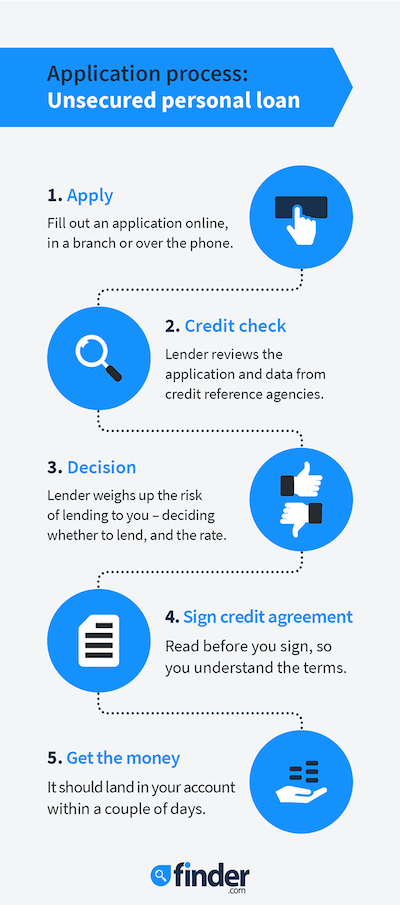Looking to apply for a personal loan but want to know more? Find out how they work and how you can apply. Whatever you’re looking to take out a personal loan for – to finance a new or used car purchase, consolidate debt, pay for a holiday or even cover wedding costs – there are a variety of personal loans to choose from. Use the guide below to help you choose the right one for your needs and situation.
How do personal loans work?
Personal loans work in very much the same as any other type of loan. You borrow a certain amount of money from a bank or lender so that you can pay for the things you need to. You will have an agreement with the lender to pay back your loan in regular repayments – normally monthly.
Essentially, a personal loan helps you fill a short-term or medium-term need for finance – they typically cover periods of up to seven years. You apply for a loan from a lender who then assesses your suitability for the loan, and if you are approved the lender will send you the funds for the loan. Each of your repayments will cover part of the capital plus the interest accrued so far. If you make your repayments as set out in your loan contract, your entire loan will be repaid when your loan term ends.
The personal loan process
Comparison Eligibility Application Approval Loan funding Repayment Loan closure
Step 1: Comparison
Finding the right personal loan is the first step of the process. But how should you compare them? There’s more to it than the APR. Here are some key features to compare:
Step 2: Eligibility
Lenders have set minimum eligibility criteria for their personal loans. This can include any of the following:
- Age. You will need to be 18 to apply for a loan. Some lenders may require you to be over 21.
- Income. You may need to earn over a certain amount to be eligible to apply for a loan. This will normally be verified by the last three months’ payslips, bank statements and/or a tax return.
- Employment. While most lenders will require you to be employed, some will consider unemployed applicants. Some lenders will require you to be out of your probation period with your current employer.
- Residency. You will normally have to be a UK citizen or permanent resident to be eligible for a personal loan.
However, even if you meet the minimum requirements for a loan you will not be approved unless you can prove you can afford the repayments. Lenders determine this by looking at your income, expenditure, outstanding debts, credit history and the stability of your employment.

Step 3: Application
The application process for a personal loan differs between lenders. Generally, you will have the option of applying online or in-branch (if the lender has branches) or over the phone. You can find a list of documents and information required to complete the personal loan application on finder.com review pages and on the lender’s website. It’s likely to involve some or all of the following:
- Proof of ID. Such as an acceptable form of photo ID, such as a passport or drivers licence.
- Proof of address. Such as a recent bank statement or utility bill.
- Proof of income. Depending on the lender, you’re likely to need three months of payslips and bank statements or two years’ of tax returns if you’re self-employed.
- Other financial documents. If you have other debts, such as loans or credit cards, you may need to show statements from those accounts.
Online applications usually take about 15 minutes to complete.
Step 4: Approval
Some lenders can give you an answer instantly while others may take a few days to approve you. There are two forms of approval: full approval or conditional approval.
Conditional approval usually takes less time but is given pending more information from you, such as additional payslips or documents relating to your assets or debts. Lenders may just ask for this information and not offer any conditional approval. This is to help them make a more informed lending decision.
Full approval is given when you have supplied sufficient information for the lender to make a decision the lender has approved you for the loan.
Step 5: Loan funding
Your loan can be funded in different ways depending on the type of loan it is and what you are using it for. For example, when you take out a car loan the lender may pay the car seller directly. This is often the same case with a debt consolidation loan as well, with the lender directing funds to your debtors directly rather than to you.
More commonly, if the loan is an unsecured personal loan, the funds will be sent to an account you nominate. Some lenders can transfer funds on the same day you apply while others might take a few days following approval.
Step 6: Repayment
Most lenders will allow you to choose the day on which repayments are taken. Some may even allow you to opt for weekly or fortnightly repayments, but may charge extra for this service. Generally, the more often you repay your loan the less interest you will pay. When choosing your repayment structure you may also want to consider additional and early repayments.
- Find out if your lender will charge fees for additional repayments.
- Check if your lender has restrictions on how much you can repay extra per year.
- If there’s a chance you could repay early, check if doing so will actually save you money on interest.
Some personal loans incorporate an optional “repayment holiday” facility, for example a two month gap at the start of your loan. Just bear in mind that your debt will continue to accrue interest during a repayment holiday, making a loan more expensive overall.
Step 7: Loan closure
If you are simply making your repayments as set out in your loan contract, then your loan should be closed following your final repayment. However, if you are planning to repay your loan early, it’s a good idea to call the lender and get a final settlement figure before you do so. This is to ensure the loan will be closed when you make your final payment and you won’t be charged any unexpected interest.
Compare personal loans
Finder Score for unsecured loans
To make comparing even easier we came up with the Finder Score. Speed, features and flexibility across 60+ lenders are all weighted and scaled to produce a score out of 10. The higher the score the better the lender – simple.
Read the full methodologyQuestions we’ve been asked about how personal loans work
More guides on Finder
-
Abound personal loan (formerly Fintern loans) review
Abound (formerly Fintern) is a UK lender that promises to offer borrowing “reinvented”, with affordable tailored loans.
-
Marks & Spencer loan calculator
Considering an M&S Bank personal loan? Use our calculator to work out how much you’ll pay back and how M&S holds up against the competition.
-
Let our Novuna loans calculator do the work
Novuna (formerly Hitachi) Personal Finance is not a bank – it’s a simplified, online finance provider from Japan that makes instant decisions on personal loans. Check out whether Novuna could be the yin to your financial yang.
-
Browse personal loan providers: A to Z list
Planning a large expenditure like some home improvements, a wedding or a new car? Looking to simplify existing debt? Then an unsecured personal loan could help you. Here are some popular UK lenders that we review and compare.
-
Post Office loans calculator and review
Compare Post Office fixed-rate personal loans against products from a range of UK lenders. Apply online and secure a competitive rate.
-
Tesco loans calculator and overview
Compare Tesco fixed-rate personal loans against products from a range of UK lenders. Apply online and secure a competitive rate.
-
M&S personal loans calculator and review
Find out more about M&S unsecured personal loans of between £1,000.00 to £25,000.00 Enjoy a fixed rate, no setup fees and the option to defer repayments for the first three months.
-
AA personal loans review
Find out all you need to about personal loans from the AA. Fast, simple comparison with a range of UK lenders.
-
Halifax loans calculator and review 2025
Compare Halifax fixed-rate personal loans against products from a range of UK lenders. Apply online and secure a competitive rate.
-
NatWest personal loans calculator
Compare NatWest fixed-rate personal loans against products from a range of UK lenders. Apply online and secure a competitive rate.
